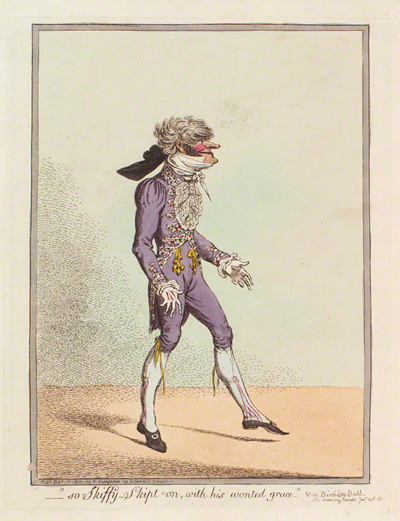Welcome to James Gillray: Caricaturist
Portrait Caricaturist
![James Gillray. [Lady Cecilia Johnston]
Courtesy of the National Portrait Gallery](images/bm_cecilia.jpg)
© Trustees of the British Museum
Gillray is best known for his political and satiric caricatures, but he was also arguably the most innovative and accomplished English portrait caricaturist of the 18th century. He produced more than 150 prints of what can safely be called portrait caricatures and, of course, many hundreds more political and satiric prints containing caricature portraits of their subjects.
In 1775 when Gillray first began working, most of the portrait caricatures he would have seen were "macaroni prints," the products of Matthew and Mary Darly's shop. These were full-length, profile drawings, usually uncolored, and, since many were drawn by amateurs, distinctly flat and fairly crude.
But as a student of the art, Gillray would also have been aware of caricatures by Ghezzi and Townshend that featured head and shoulder profiles in small, card-sized formats. Gillray's first portrait caricatures appear in May of 1780, five years after he entered the print-making trade. Like the Ghezzi and Townshend drawings, they are uncolored, card-sized (approximately 4 x 3 inches), head and shoulder portraits in profile. They may have begun as studies—Gillray simply trying his hand at caricature—and then have been printed when they proved so successful. The one of the sour-faced Lady Cecilia Johnston eventually found its way into Gillray's more finished prints, Saint Cecilia [1782] and La Belle Assemblee [1787]. The caricature of Lady (Mount) Edgcumbe appears with only minor changes in La Belle Assemblee [1787] and A Witch upon a Mount's Edge [1791]. But even here, in his first attempts, Gillray's work is more accomplished and expressive than most of his English contemporaries

© National Portrait Gallery, London
Portrait caricatures like Ghezzi's were witty and ironic, but only seldom added enough context or detail to give that irony the specific direction of satire. In general, the macaroni prints of the early 1770s followed this Italian model, providing only enough detail to identify the figure, but stopping short of outright satire. Gillray's [Lady Cecilia Johnston] [1780] is a brilliant example of such ironic regard. Gillray continues to produce portrait caricatures that remain close to the Italian tradition of irony with only minimal satiric intent for the rest of his career. Examples include Enter Cowslip with a Bowl of Cream [1795], Elegance Democratique [1799], All Bond Street Trembled as he Strode [1802], The Inexpressible Air of Dignity [1803] and Maecenas in Pursuit of the Fine Arts [1808]. But it is certainly not surprising that Gillray, as seasoned as he was in satiric political caricature, would go on in prints like St. Cecilia [1782] and Melpomene [1784] to add the necessary context to turn irony into devastating satire.
The only thing that is truly surprising is that it took until 1791 before Gillray routinely includes portrait caricature as part of his standard repertoire. But in 1791 there is a veritable explosion of single figure caricatures, usually still in profile, some standing, some sitting, often including a significant amount of situational detail that both defines and satirizes the subject. Examples include The Finishing Touch [1791], Patience on a Monument [1791], Patent Bolsters... [1791], A Witch, upon a Mount's Edge [1791], Le Derniere Ressource...[1791], and some paired portrait caricatures: At Church 1791], and At the Opera [1791], and the wonderful duo of Frying Sprats [1791] and Toasting Muffins [1791].
After 1791, Gillray produces first-rate single figure portrait caricatures in a variety of poses, with varying degrees of pure irony or outright satire, but now using every bit of his skill in draughtsmanship and print-making. Examples abound.
![James Gillray. [Prince of Wales].
Trustees of the British Museum](images/bm_prince-back.jpg)
© Trustees of the British Museum
Full length portraits include A Natural Crop [1791], A Voluptuary under the Horrors of Digestion [1792], A Democrat [1793], So Skiffy Skipt On, with his Wonted Grace [1800], Mental Energy [1801], Fat Cattle [1802], Hope [1802], and A View of Newmarket-Heath [1807], and Mother Goose [1808].
Seated or partial figure portraits include all of the portraits included in the seven plate Eloquence series [1795], such as Naval Eloquence and Fools Eloquence, Quiz-zing a Filly [1795] Un Diplomatique... [1797], A Standing Dish at Boodles [1800], and others.
Inspired, perhaps, by the popularity of Stubbs's painting of horses, Gillray places a number of his subjects on horseback, including Georgey a Cock Horse [1796], Brigade Major, Weymouth [1797], and A Scotch Poney, Commonly call'd a Galloway [1803].
But perhaps his most interesting variation is a series of wonderful caricatures in which the subject is seen from behind. These include Back View of a Cape, [1792] The Shadow of a Duke [1795], Patern-Staff. Weymouth [1795], and From Sir William Hamilton's Collection [1801].
Gillray will often allude to his participation and parody of the serious portrait tradition by including his subject in an etched and colored "frame" as in Shadow of a Duke [1795], or in a portrait oval as in Nauticus [1791], or A True British Tar [1795]. And in his wonderful series The New Pantheon of Democratic Mythology 1799, Gillray takes the serious portrait convention of portraying contemporary sitters as classical figures to hilarious lengths.